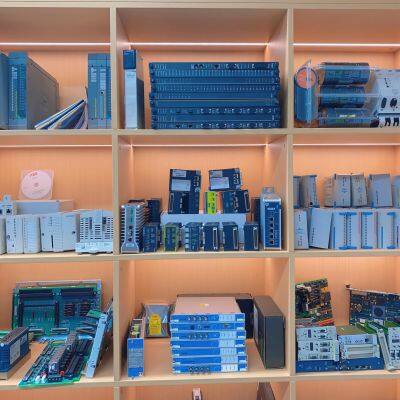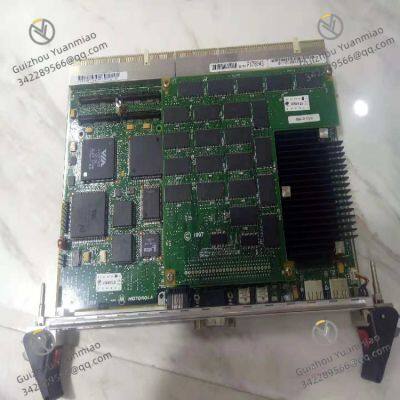Product Description
I. Core Advantages
(1) High-Performance Processing Capability
The MCP750 is equipped with a PowerPC processor, which injects powerful computing momentum into the equipment. Processors such as the PowerPC 603 or 604 models offer optional clock frequencies of 233MHz, 366MHz, and 466MHz, enabling it to easily handle real-time control and large-volume data processing tasks. In industrial automated production lines, it can quickly process equipment operation data, accurately regulate production processes, and ensure the efficient and stable operation of the production line.
(2) Flexible Expansion Features
It adopts a modular design concept and is equipped with abundant interface resources. It comes with various interfaces including PCI, Ethernet, serial ports, and parallel ports, facilitating connections to a wide range of peripheral devices. Whether it is connecting to sensors for data collection or linking to actuators for control command output, this can be easily achieved. Meanwhile, the modular design simplifies system expansion and maintenance. Users can flexibly add or replace modules as needed to adapt to the requirements of projects of different scales and complexities.
(3) High Reliability Guarantee
From hardware material selection to overall architecture design, it adheres to industrial-grade standards. Its robust housing can effectively resist dust, vibration, and moderate water splashes. Some models reach the IP54 protection level, allowing stable operation in harsh environments such as dusty mines and humid chemical workshops. In terms of electrical performance, it possesses excellent anti-interference capability, ensuring accurate data transmission and processing, and strongly guaranteeing the continuity and stability of industrial production processes.
(4) Strong Standard Compatibility
It strictly complies with the CompactPCI standard, enabling seamless integration with various industrial control systems that follow this standard. When building large-scale industrial automation networks, the MCP750 can be smoothly integrated into the existing system architecture, reducing the difficulty and cost of system integration, and improving the compatibility and collaborative work capability of the entire system.
II. Technical Specifications
(1) Electrical Specifications
Operating Voltage: The common operating voltage range is 12V DC – 48V DC. It can adapt to different industrial power supply environments, ensuring stable power acquisition under various power supply conditions and maintaining the normal operation of the equipment.
Output Frequency: The output frequency range is 1kHz – 100kHz. It can meet industrial control scenarios with different requirements for signal output frequency, realizing accurate and high-speed signal output and ensuring timely system response.
Certification Standards: The product has passed the ISO 9001 quality management system certification and CE certification. In aspects ranging from production processes to product safety and performance, it complies with international authoritative standards, providing reliable quality assurance.
(2) Physical Specifications
Dimensions: The typical dimensions are approximately 160mm x 100mm x 30mm. Its compact design means it does not occupy excessive space when installed inside industrial equipment with limited space, facilitating the miniaturized and integrated layout of the equipment.
Weight: It weighs about 0.5kg. The lightweight design not only makes equipment installation and transportation convenient but also reduces the overall load pressure during equipment operation, which is beneficial for the long-term stable operation of the equipment.
Operating Temperature Range: It can operate normally in extreme temperature environments ranging from -40°C to +85°C. Whether in extremely cold outdoor working environments or near high-temperature industrial furnaces, it can run stably, greatly expanding the application scope of the product.
(3) Hardware Configuration
Processor: The core PowerPC processor is responsible for performance. Depending on different models, it provides the equipment with powerful and stable computing and data processing capabilities, serving as the key hardware foundation for realizing efficient control functions.
Memory: Multiple memory capacity options are available, including 32MB, 64MB, 128MB, and 256MB. It can be flexibly configured according to the data storage and operation requirements of actual application scenarios to ensure smooth system operation.
Interface Resources: The rich and diverse interfaces have been detailed earlier. These interfaces are like the "tentacles" of the equipment, enabling stable connections with various external devices and realizing efficient data transmission and interaction.

III. Functional Features
(1) Signal Processing Function
Accurate Data Acquisition: Relying on its abundant input interfaces, it can accurately collect analog or digital signals from various industrial sensors such as temperature sensors, pressure sensors, and flow sensors. In industrial production, it comprehensively and in real-time acquires the operation data of all key parts of the equipment, providing detailed and accurate data support for subsequent system analysis and decision-making.
Efficient Signal Conversion: It can flexibly and efficiently realize the mutual conversion between analog signals and digital signals according to actual control requirements. This flexible conversion capability allows the MCP750 to smoothly connect with different types of industrial equipment and systems, significantly improving system compatibility and facilitating integration and application in various industrial automation projects.
Reliable Signal Isolation: It adopts professional signal isolation technology to effectively isolate high-voltage signals from low-voltage signals and prevent mutual interference between them. In complex industrial environments, electromagnetic interference generated by the operation of high-voltage equipment can easily affect the accuracy of low-voltage signal transmission. However, the signal isolation function of the MCP750 ensures stable signal transmission, greatly enhancing the system's anti-interference capability and guaranteeing the reliable operation of industrial control processes.
(2) Control Output Function
It can accurately send control commands generated by the system to various actuators such as industrial valves and motors. In industrial automated production lines, based on the collected real-time data and the system's preset control strategies, it issues action commands to actuators in a timely and accurate manner, realizing precise control of key equipment in the production process. For example, in chemical production, it can accurately adjust the opening degree of feed valves and the rotation speed of stirring motors according to parameters such as temperature and pressure in the reaction kettle, ensuring stable, efficient, and safe chemical production.
IV. Application Fields
(1) Industrial Automation
Production Line Control: It is widely used in control and monitoring systems for manufacturing equipment and production processes. It accurately controls mechanical equipment on the production line, such as machine tools, conveyors, and assembly robots. By real-time monitoring the operation status of equipment and adjusting production parameters in a timely manner, it improves production efficiency, reduces labor costs, and ensures consistent and stable product quality.
Robotics and Intelligent Automation: It provides core computing and control support for robot control systems, enabling them to perform tasks accurately. In intelligent warehouse logistics, it controls the operation paths and actions of AGVs (Automated Guided Vehicles) to achieve efficient cargo handling and storage.
SCADA Systems: In monitoring and data acquisition systems, it is responsible for collecting and processing various on-site data, and issuing control commands to on-site equipment. This realizes remote monitoring and management of industrial production processes, improving the efficiency of production management and the scientificity of decision-making.
(2) Telecommunications Field
Network Equipment: It is used in network equipment such as network routers and switches, providing efficient data processing and forwarding capabilities to ensure smooth and stable network communication. In data center network architectures, it facilitates fast data exchange and routing, improving the overall performance of the network.
Communication Gateways: As a gateway in communication systems, it realizes data conversion and transmission between different communication protocols and networks, breaking down communication barriers and promoting interconnection and intercommunication among various communication equipment and systems.
(3) Medical Equipment
Diagnostic Equipment: In medical diagnostic equipment, it undertakes data processing and analysis tasks. For instance, in medical imaging equipment, it quickly processes imaging data to help doctors accurately diagnose diseases.
Medical Data Processing: It integrates and analyzes various medical monitoring data, providing data support for medical decision-making and improving the quality and efficiency of medical services.
(4) Military and Aerospace
Embedded Computing: It is applied in rugged, mission-critical embedded computing systems, such as military communication equipment and radar systems. It ensures stable equipment operation in harsh environments, guaranteeing the smooth execution of military missions.
Flight Control: In flight control systems and UAVs (Unmanned Aerial Vehicles), it is responsible for key tasks such as flight attitude control and navigation data processing, ensuring the flight safety of aircraft and the accuracy of mission execution.
(5) Automotive Industry
Advanced Driver Assistance Systems (ADAS): It processes data from various sensors to implement advanced driver assistance functions such as adaptive cruise control, automatic emergency braking, and lane departure warning, enhancing driving safety and comfort.
In-Vehicle Infotainment and Navigation Systems: It provides computing support for in-vehicle infotainment systems, enabling functions such as multimedia playback and vehicle information display. At the same time, in navigation systems, it processes positioning data in real-time to provide accurate navigation guidance for drivers.


MOTOROLA MVME162-512A Embedded Controller
MOTOROLA MVME162-522A Embedded Controller
MOTOROLA MVME162-533A Embedded Controller
MOTOROLA MVME162-13 Embedded Controller
MOTOROLA MVME162-10 Embedded Controller
MOTOROLA MVME117A CPU Board
MOTOROLA MVME188A CPU Board
GE VMIVME2540 Intelligent Counter Controller Module
ICS TRIPLEX TC-303-02-4M0 Trusted I/O Companion Slot Cables
MOTOROLA MVME300 GPIB VMEbus Module
MOTOROLA MVME335 4-Channel Serial And Parallel Interface Board
MOTOROLA MVME705B 6-Channel Serial Transition Module
 yezi
Hi there! Welcome to my shop. Let me know if you have any questions.
yezi
Hi there! Welcome to my shop. Let me know if you have any questions.



